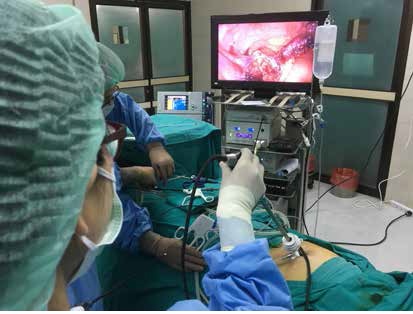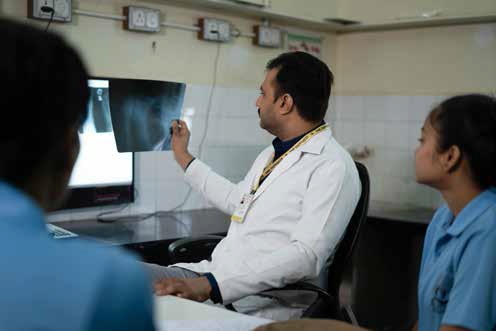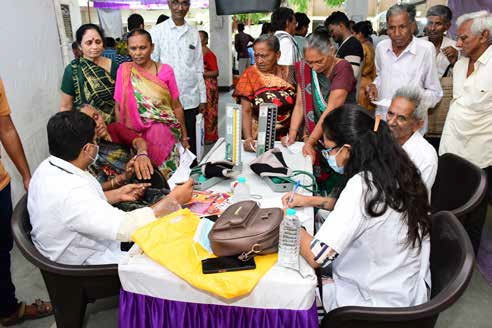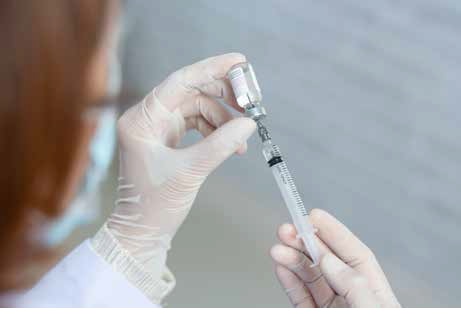- Have any questions?
- (+91) 02792 230240
- info@smcgh.edu.in

Mega Health Camp: Towards a Healthy Amreli
June 30, 2022
How India’s monsoon season might impact covid 19:
July 21, 2022Laparoscopic Surgery at Shantabaa General Hospital:
The Procedure, the Safety & the Painless Recovery
Some inventions change the entire perspective of how a certain kind of thing is done and
bring about a revolution. These inventions make life less complicated and more convenient,
and then you cannot even imagine life without them. One such invention is Laparoscopy,
which has brought about a whole new possibility to the world of surgeries and medical
procedures, making them minimally invasive and helping treat erstwhile complicated cases
with better precision.
Laparoscopy is a surgical procedure that allows a surgeon to access the inside of the
abdomen and pelvis without making large incisions in the skin. It is also known as keyhole
surgery or minimally invasive surgery. It is named "Laparoscopy" because the surgeon uses
a laparoscope instrument, a small tube with a light source, and a camera that relays a
television monitor with views of the inside of the abdomen or pelvis. Then, the practitioner
puts it into the abdomen through a very tiny cut. (An incision is a small cut made through the
skin during the surgery). Finally, they send the photographs to a monitor in video form. This
process allows a surgeon to view the inside of the body without significant trauma to the patient.

When is Laparoscopy used?
Today, we use laparoscopy to treat conditions that develop around the abdominal or pelvic area in the human body. We take this route when the non-invasive methods are not helpful.
The significant reasons are:
1. To look inside to find out the real cause of the problem. Imagining techniques like MRI,
ultrasound, CT scan, and X-ray do not provide enough information
2. To perform surgery for the removal of organs or tissues.
3. To take a sample from a particular organ for further examination is also called a biopsy.

Organs like the appendix, gallbladder, liver, pancreas, small intestine, large intestine,
spleen, stomach, and reproductive organs can be examined and treated with the help of
Laparoscopy. In addition, tumours, blockages, internal bleedings, and infections can be
diagnosed with this procedure.
Doctors are performing the below mentioned significant surgeries with the help
of Laparoscopy:
Removing an inflamed appendix
Removing the gallbladder or gallstones
Removing a section of the intestine
Repairing hernias
Repairing stomach ulcers
Perform Weight loss surgery
Removing organs affected by cancer
Laparoscopic surgeries are most helpful to women in diagnosing and treating various
conditions
Fibroids: it is an unnecessary growth inside or outside the uterus.
Ovarian cysts: Are the fluid-filled sacs that form inside or on the surface of an ovary.
Endometriosis: It is a condition in which tissue that usually lines the uterus grows
outside of it.
Pelvic prolapse: It's when the reproductive organs fall into or out of the vaginal canal.
Ectopic pregnancy: a pregnancy that grows outside the uterus, which can be lifethreatening for a pregnant woman.
Hysterectomy: The removal of the uterus to treat cancer, abnormal bleeding, or other
disorders
Tubal ligation: A procedure to block fallopian tubes to prevent pregnancy.

The five types of cancer that medical practitioners are mainly diagnosing using Laparoscopy
are as follows:
- Liver cancer
- Pancreatic cancer
- Ovarian cancer
- Cancer of the bile duct
- Cancer of the gallbladder
The process:
We perform Laparoscopy under general anaesthetic, so the patient stays unconscious
during the procedure. First, we make a minimal cut near the navel button. Then we use this
incision to introduce the laparoscope. Next, this makes the abdomen expand to make it
easier to see the organs. Finally, we make a second incision near the pubic hairline to offer
an additional entry for instruments needed for minor surgical procedures. After the
laparoscopic procedure, we generally permit the patient to leave somewhere between 4-8
hours. We rarely advised them to stay overnight for healing.
Benefits of Laparoscopy:
This way of surgery has many benefits compared to the traditional method of doing it, mainly
because it is minimally invasive.
Scars are small, likely less than an inch.
Recovery is quick and less painful.
Usually, discharge is allowed the very next day.
Minor internal scarring.
The patient can get back to work after 2 or 3 weeks of surgery.
Low cost, because the time spent in hospital is significantly less.
Laparoscopy at Shantabaa Medical College and General Hospital (SMCGH)
Shantabaa Medical College and Hospital is established under Gajera Trust in the Amreli
district of Gujarat with a vision to achieve excellence in Medical Education, Health Care, and
Research. The Obstetric and Gynecology department of the hospital has started Laparoscopic
surgeries apart from routine obstetric and gynaecological procedures. The experts at
Shantabaa have successfully done more than 10 Laparoscopic surgeries, including simple
diagnostic Laparoscopy, complex tubo-ovarian surgeries, and Laparoscopic difficult
hysterectomies.
SMCGH has recently come up with an initiative to provide laparoscopic surgeries at zero cost
to the needed ones from rural areas with the support of the medicine,anaesthesia, and surgical
department, who have already worked as a team. They aim to provide the best facilities at an
affordable cost to all sections of society. This is not the first time they are going grand. We
have done various drives and camps in the past

Success story
"In a recent case, we used an epidural catheter and administered medicines regularly to
maintain anaesthesia, which lasted over 7 hours. It was the first time this treatment was
performed in our facility, and it was a success, giving us the confidence to employ
Laparoscopy to save many more lives in the future."

Laparoscopy has proved to be helpful and successful for many years. SMCGH is taking these
steps to increase awareness about it in the rural section of society and let people know how
beneficial this treatment can be for treating crucial health problems. They aim to reach every
village, one at a time



